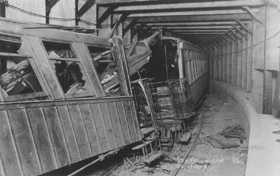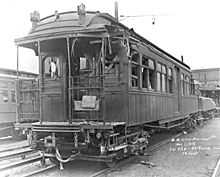Malbone Street Wreck
| Malbone Street Wreck | |
|---|---|
 Remains of the wreck | |
| Details | |
| Date | November 1, 1918 |
| Time | 6.42 p.m. |
| Location | Flatbush, Brooklyn |
| Country | United States |
| Rail line | Brighton Beach Line |
| Operator | Brooklyn Rapid Transit Company |
| Type of incident | Derailment |
| Cause | Excessive speed round curve |
| Statistics | |
| Trains | 1 |
| Deaths | 93[1]–102[2] |
The Malbone Street Wreck, also known as the Brighton Beach Line Accident of the Brooklyn Rapid Transit Company (BRT), was a rapid transit railroad accident that occurred November 1, 1918, beneath the intersection of Flatbush Avenue, Ocean Avenue, and Malbone Street (now known as Empire Boulevard), in the community of Flatbush, Brooklyn. At least 93 individuals died, making it one of the deadliest train crashes in the history of the United States.[1]
Outline

The wreck occurred the evening of November 1, 1918 at 6:42 PM, during the last days of World War I. An elevated train, consisting of five cars constructed primarily of wood, entered the tunnel portal beneath Malbone Street going toward the Prospect Park station, negotiating a curve designated to be taken at six miles per hour (9.6 km/h) at a speed estimated at between 30 and 40 mph (48–65 km/h). The trailing truck of the first car derailed, and the two following cars completely left the tracks, tearing off their left-hand sides and most of their roofs. The first and fourth cars sustained relatively minor damage, while the second and third cars were severely damaged, the third so badly that it was dismantled on the spot. The fifth suffered no damage at all. The motorman was not injured and left the scene of the accident.
Causes of the wreck
The Malbone Street Wreck was not caused by any single event or failure, but a series of individual circumstances, the omission of any one of which might have prevented the accident or at least reduced its severity.
The BLE strike
The Brotherhood of Locomotive Engineers (BLE), representing some of the motormen operating elevated trains of the BRT, went on strike from the company on the morning of November 1 over issues involving union organization and the discharge from employment of a number of BLE members. This created a shortage of motormen to operate the system.
The motorman
The motorman was Edward Luciano, a crew dispatcher with light experience operating elevated trains, who was pressed into service during the strike emergency. He had never operated an elevated train in passenger service before. He was not familiar with the Brighton Beach Line, and his only experience moving trains was parking non-revenue trains in a train yard a year earlier. He had been taken over the line earlier by a motorman-instructor as part of his two hours of training prior to the disaster. Normally a motorman in that era received sixty hours of training before being allowed to control a revenue-generating train.
The speed of the train
The train was operating at a speed of at least 30 mph where it should have been operated at 6 mph or less in the section of track it was in when it derailed. The motorman stated during his interrogation that he had attempted to slow the train, but the subsequent investigation of the wreck indicated that no attempt to engage the emergency brake had been made and that he had not attempted to reverse the train's motors. Witnesses interviewed by the New York Times also stated that the train had not slowed approaching or in the S curve until the cars left the tracks. In the minutes leading up to the wreck, the motorman had difficulty timing the train's progress, overshooting multiple stations.
The tunnel
The single-track tunnel in which the wreck occurred had been opened only weeks prior to the accident. It consisted of a sharp reverse curve designed to take Coney Island-bound trains of the Brighton Beach Line around a new mainline which was then under construction. Previously, these trains entered Prospect Park through an older tunnel, which provided a straighter direct route. Trains going northbound didn't have the problem of the tunnel, as they came straight out of Prospect Park and used the original track that led onto the BMT Franklin Avenue Line.
The makeup of the train
The train consisted of three motor cars and two trailer cars. The motor cars were about twice as heavy as the trailer cars, and the trailers were significantly more top-heavy, especially with a passenger load. Standard procedure was to never couple two trailer cars together, but to always have a single trailer between two motor cars. The heavier motor cars provided stability for the lighter trailers. In the Malbone Street wreck train, two trailers were coupled together, and it was these two cars, in order numbers 80 and 100, that sustained the bulk of the damage, both physical and human.
Culpability
The BRT tried to keep service running with non-striking personnel, which included men in other unions, including the company union as well as other personnel, and made the decision to use Luciano, a crew dispatcher. There is no report that he had made other mistakes prior to the accident, though he had to negotiate difficult conditions, including other sharp curves and running on the street where other traffic and pedestrians would have added to operating hazards. He was switched onto the wrong line at the junction prior to the final approach to the tunnel, but that was due to his train lacking proper signals to inform the switch tower operator which route the train was to take. Luciano had to reverse his train in order to take the proper route, but this was done "by the book" without further incident.
In the present day, a struck transit system ordinarily closes down in an orderly fashion until the strike is resolved. But in 1918, the BRT would likely have been more criticized for not attempting to keep the system running, absent the accident.
New York City Mayor John F. Hylan and his administration placed blame on the BRT, bringing both Luciano and company officials to trial for manslaughter. With a change of venue the trial was held in Nassau County.
The prosecutorial focus required the BRT to present a coherent defense on behalf of both its officials and Luciano. Because of this, neither the proximate cause of the wreck nor the excessive speed of the train has ever been adequately explained. Luciano testified on his own behalf, contending that he was in control of the train, but the train did not respond properly, a claim belied by the BRT's own physical examination of the equipment, which showed that the brakes were in good operating order, were not placed in "emergency" application, and that other means of slowing or stopping the train, such as reversing the motors, had not been done. Since his defense focused on these contentions, other issues that could have caused him to operate the train at speed were not examined, such as his state of mind (he was suffering from insomnia after losing a child to Spanish influenza and was working a double shift), a desire to make up time because of the earlier switching problems or his understanding of the route on which he was operating.
Ultimately all the defendants were acquitted or had the indictments eventually dropped. One official received a hung jury and was not retried. Luciano went into the real estate business and disappeared from the record.
There were two large awards of damages against BRT in the courts afterwards. Ethel Holmes the widow of George W Holmes was awarded $40,000, and Ethel Pierce was awarded $30,000.
Aftermath
The accident placed more pressure on the BRT to remove wooden equipment from routes that operated through tunnel sections or in subways, though this use was already limited, and the cars, structurally made of wood, may not have affected the severity of the accident. That notwithstanding, wooden cars returned to use in the tunnel for another nine years, and cars of partial wooden construction remained in elevated service until 1969.
Additional safety devices were added to the subway and elevated system over the years, including more effective dead-man's controls to halt runaway trains, and signalling and automatic trackside devices called trippers or train stops to reduce the likelihood of trains operating too fast for conditions.
The three motorized cars involved in the wreck, 726 (the lead car), fourth car 725, and final car 1064, were repaired and returned to service. The severely damaged trailers, 100 and 80, were scrapped; car 80 was cut up in the wreck cleanup.
The Malbone Street tunnel in which the wreck occurred continued in daily passenger operation for 40 years, although it was no longer part of the main line after 1920. The tunnel today is part of the Franklin Avenue Shuttle and is used occasionally for special moves. In 1974 an accident occurred at the same site when a slow speed train derailed and hit the wall. There were no injuries.[3]
In the wake of the tragedy, Malbone Street was renamed Empire Boulevard, a name it still bears today.
Similar accidents
Similar accidents involving sudden very sharp curves include:
-
 Morpeth rail crashes (five occasions) - England
Morpeth rail crashes (five occasions) - England -
 Rosedale train crash - Australia
Rosedale train crash - Australia -
 Waterfall train disaster - Australia
Waterfall train disaster - Australia -
 Amagasaki rail crash - Japan (2005)
Amagasaki rail crash - Japan (2005) -
 Santiago de Compostella derailment - Spain (2013)
Santiago de Compostella derailment - Spain (2013)
References
- ↑ 1.0 1.1 Cudahy, Brian (1999). The Malbone Street Wreck, New York: Fordham University Press. p. 81.
- ↑ Sansone, Gene (2004). New York Subways: An Illustrated History of New York City's Transit Cars. Baltimore: Johns Hopkins University Press. p. 165. ISBN 0801879221.
- ↑ BMT Franklin: Prospect Park
- Brooklyn Daily Eagle October 27, 1919 p10.
External links
- AmericanHeritage.com Death in the Subway by David Rapp
- Review of book about Malbone Street wreck
- Account of the Malbone Street wreck by www.nycsubway.org, including contemporary stories from New York Times
- Description of current day usage of the tracks with a picture of a portion of the S track.
Coordinates: 40°39′46″N 73°57′45″W / 40.66278°N 73.96250°W
| ||||||||